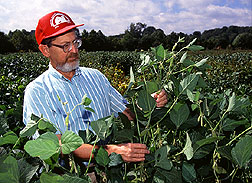Giant Soybeans Have Multiple Uses
|
|
The product of 19 years of breeding, Derry, Donegal, and Tyrone are the first improved forage-type soybean cultivars bred for animal feed.
Soybeans were originally grown in the United States as forage for livestock. In 1924, a million acres were planted for hay. But use of soybeans as hay soon declined because of the difficulty in drying the forage. Instead, soybeans as a grain became the wonder crop of the 20th century, with their oil and protein used in many food and industrial applications. By 1964, only 3 percent of U.S. soybeans were being grown for forage.
But soybeans as a forage are primed for a comeback, says Thomas E. Devine, a plant geneticist with the Agricultural Research Service. This is partly because improved technology for ensiling it has reduced the need for drying the crop. And with the new varieties, dairy and livestock producers have new opportunities for using soybeans as a high-quality, nutritious forage.
"They can be used for grazing, hay, or silage over a wide geographic area of the United States," says Devine, who is based at the ARS Weed Science Laboratory in Beltsville, Maryland.
The varieties differ in maturity dates, disease resistance, and areas where they will grow best. "Donegal matures earliest and is suited to the Northeast," says Devine. "Derry matures later and is ideal for the Midwest, and Tyrone matures last and is best for the South."
To breed the new soybeans, Devine crossed an old hay type with modern grain cultivars having resistance to diseases such as Phytophthora root rot. Later genetic selection for plant height, branching, lodging resistance, pod set, and leafiness produced lines that grow 6 feet tall.
"Short, conventional grain-type soybean plants are not as well suited for high forage yields," says Devine. "These giants have exceptional vigor and continue growing after other soybeans stop. That's the key to their high forage production."
In tests in several states through 1996, the forage soybeans have produced over 6 tons of dry matter per acre, exceeding conventional soybean yields by up to 75 percent. Last spring, Devine shipped seeds of the three new varieties for performance testing to 19 states.
On their roots, soybeans harbor soil bacteria that take nitrogen from the air and convert it to a form plants can use as fertilizer. The new varieties can produce high yields without added nitrogen fertilizer.
Scientists at Beltsville's Nutrient Conservation and Metabolism Laboratory and at several universities have found the new forage ranks high in nutrient composition and quality. In feeding trials with Holstein heifers at Beltsville, all three varieties were as palatable as alfalfa.
The forage soybeans offer advantages over conventional soybeans in states from Maryland southward, where the long growing season and mild winters allow farmers to double-crop. After harvesting soybeans in the fall, many farmers plant a small grain--wheat or barley--that is harvested in the spring or grazed by livestock.
Devine believes there are ecological and economic advantages, too. The small-grain crop in fall absorbs nitrogen from the soil and preserves it in plant tissues--rather than releasing it into streams and lakes. And the forage soybeans can be harvested a month earlier than conventional grain soybeans. This allows the small-grain crop to be planted earlier and gives it more time to grow when days are longer and the soil is warmer.
In developing the new varieties, Devine worked with Elwood O. Hatley of Pennsylvania State University and David E. Starner at Virginia Polytechnic Institute and State University. ARS has applied for plant variety protection for the new soybeans.--By Hank Becker, Agricultural Research Service Information Staff, 6303 Ivy Lane, Greenbelt, Maryland 20770, phone (301) 344-2769.
Thomas E. Devine is at the USDA-ARS Weed Science Laboratory, Bldg. 001, 10300 Baltimore Ave., Beltsville, MD 20705-2350; phone (301) 504-6375, fax (301) 504-6491.
"Giant Soybeans Have Multiple Uses" was published in the May 1998 issue of Agricultural Research magazine. Click here to see this issue's table of contents.







